Deducing the Optimal Control Method for Electrochromic Triple Glazing through an Integrated Evaluation of Building Energy and Daylight Performance
Abstract
:1. Introduction
2. Methods and Materials
2.1. Research Method and Scope
2.2. Analysis of the Optical Properties of Electrochromic Glazing
3. Simulation Conditions
3.1. Overview of Analytical Simulation Model
3.2. Material and Construction
3.3. Setpoint Temperature and HVAC System
3.4. Internal Gains and Weather Data
3.5. Dimming Control
3.6. Conditions for Controlling Electrochromic Glass
4. Results and Discussion
4.1. Analysis of Hourly Energy Consumption by Controlling Condition
4.2. Analysis of Annual Energy Consumption by Controlling Conditions
4.3. Analysis of DGI and Indoor Lighting by Controlling Conditions
4.4. Deducing the Optimized Ccontrol Condition that Considers the Energy and Light Environment
5. Discussion
- (1)
- According to the analysis of the optical characteristics by a spectrometer, it was found that the solar transmittance of the electrochromic glass sample can be adjusted in the range of 41.6–48.1% when decolored, and up to 6.5% when colored. It was also found to be adjustable in the range of 52.8–64.8% when decolored, and up to 12% when colored, for the case of visible transmittance. In examining the optical characteristics after composing triple glass for construction by using the LBNL’s Optic and Window tool, the thermal transmittance showed a high thermal insulation property of 1.19 W/m2 K. The solar transmittance was adjustable in the range of 25–35.7% when decolored, and up to 10.7% when colored. The visible transmittance was adjustable in the range of 37.8–46.3% when decolored, and up to 8.5% when colored. Thus, the potential of the electrochromic glass to serve as a solar radiation controlling device was fully demonstrated.
- (2)
- Based on the results of the data analysis of the optical characteristics, the cooling and heating load, and lighting energy consumption hourly rate during a typical day in summer and winter of an office building were evaluated according to the five transmittance control conditions. This examination showed that the temperature controlling method and 50 W/m2 solar radiation controlling method have a high rate of maintaining the colored state during the summer and were advantageous in terms of the cooling load. For the heating load, the temperature controlling method and 700 W/m2 solar radiation controlling method, which have a high rate of decolored state during winter, showed a good performance result. From the perspective of lighting energy consumption, the 500 W/m2 and 700 W/m2 solar radiation controlling methods, which have high sunlight penetration rates, were found to have the edge over others during the summer; whereas the temperature controlling method that maintains the decolored state is more advantageous during the winter. The individual characteristic and tendency towards cooling, heating, and lighting energy can be identified through an analysis of the hourly data and used as basic data when developing the control conditions for electrochromic glass’ utilization.
- (3)
- When the optimized control condition of electrochromic glass was examined from the building energy perspective by analyzing the total data of annual cooling and heating load, as well as the light energy, the controlling method that colors when solar radiation is 300 W/m2 or higher was found to be most advantageous in reducing the total energy consumption rate. This is due to the large influence of lighting energy on the total annual amount of building energy through the dimming control of the light in this study. When analyzing the annual building energy data, the difference in light energy, which takes up to 25% of the total building energy, is larger with light control (approximately 5000 kWh range) than the differences in the cooling and heating load by control conditions (approximately 2000 kWh range). Therefore, a consideration of light energy was found to be necessary in developing a strategy to control electrochromic glass.
- (4)
- In terms of building environment, analyses of the DGI—that is, light environment performance—and the indoor illumination were conducted. In examining DGI, the 50 W/m2 solar radiation controlling condition, which has the highest maintenance rate, was found to perform the best. Furthermore, the glare ratio increased by more than 20% under the controlling condition of 500 W/m2 solar radiation, resulting in a high probability of reducing the level of user satisfaction from the building environment perspective. Moreover, the temperature controlling method maintains the decolored state during the winter, which has a low sun altitude; this was found to cause a high level of bad quality glare, thereby confirming that it is not an effective controlling method. In analyzing indoor illumination, the controlling method with the highest rate of time falling within the proper annual illumination range is found to be the 300 W/m2 solar radiation control condition. The temperature control condition had much less uniformity in annual indoor illumination, whereas the 50 W/m2 solar radiation condition showed that the indoor illumination value was much lower than the KS approved criteria. The condition of 500 W/m2 solar radiation or higher resulted in data with indoor illumination values that were too high, and is thus found to be disadvantageous from the light environment performance perspective.
6. Conclusions
Author Contributions
Funding
Conflicts of Interest
References
- Oh, M.H.; Lee, K.H.; Yoon, J.H. Automated control strategies of inside slat-type blind considering visual comfort and building energy performance. Energy Build. 2012, 55, 728–737. [Google Scholar] [CrossRef]
- Ghosh, A.; Norton, B. Advances in switchable and highly insulating autonomous (self powered) glazing system for adaptive low energy buildings. Renew. Energy 2018, 126, 1003–1031. [Google Scholar] [CrossRef]
- Ghosh, A.; Mallick, T.K. Evaluation of colour properties due to switching behaviour of a PDLC glazing for adaptive building integration. Renew. Energy 2018, 120, 126–133. [Google Scholar] [CrossRef]
- Rezaei, S.D.; Shannigrahi, S.; Ramakrishna, S. A review of conventional, advanced, and smart glazing technologies and materials for improving indoor environment. Sol. Energy Mater. Sol. Cells 2017, 159, 26–51. [Google Scholar] [CrossRef]
- HALIO Glass, Asahi Glass Co. (AGC). Available online: https://halioglass.com (accessed on 9 June 2018).
- Reilly, S.; Arasteh, D.; Selkowitz, S.E. Thermal and optical analysis of switchable window glazings. Sol. Energy Mater. 1991, 22, 1–14. [Google Scholar] [CrossRef] [Green Version]
- Piccolo, A.; Pennisi, A.; Simone, F. Daylighting performance of an electrochomic window in a small-scale test-cell. Sol. Energy 2009, 83, 832–844. [Google Scholar] [CrossRef]
- Fernandes, L.L.; Lee, E.S.; Ward, G. Lighting energy savings potential of split-pane electrochromic windows controlled for daylighting with visual comfort. Energy Build. 2013, 61, 8–20. [Google Scholar] [CrossRef] [Green Version]
- Lee, E.S.; Yazdanian, M.; Selkowitz, S. The Energy-Savings Potential of Electrochromic Windows in the US Commercial Buildings Sector; LBNL-54966; Lawrence Berkley National Laboratory: Berkley, CA, USA, 2004. [Google Scholar]
- Tavares, P.F.; Gaspar, A.R.; Martins, A.G.; Frontini, F. Evaluation of electrochromic windows impact in the energy performance of buildings in Mediterranean climates. Energy Policy 2014, 67, 68–81. [Google Scholar] [CrossRef] [Green Version]
- Ajaji, Y.; André, P. Thermal comfort and visual comfort in an office building equipped with smart electrochromic glazing: An experimental study. Energy Proc. 2015, 78, 2464–2469. [Google Scholar] [CrossRef]
- Papaefthimiou, S.; Syrrakou, E.; Yianoulis, P. Energy performance assessment of an electrochromic window. Thin Solid Films 2006, 502, 257–264. [Google Scholar] [CrossRef]
- DeForest, N.; Shehabi, A.; Garcia, G.; Greenbalt, J.; Masanet, E.; Lee, E.S.; Selkowitz, S.; Milliron, D.J. Regional performance targets for transparent near-infrared switching electrochromic window glazings. Build. Environ. 2013, 61, 160–168. [Google Scholar] [CrossRef]
- Granqvist, C.G.; Bayrak Pehlivan, I.; Niklasson, G.A. Electrochromics on a roll: Web-coating and lamination for smart windows. Surf. Coat. Technol. 2017, 6–11. [Google Scholar] [CrossRef]
- Rottmann, M.; Kraft, A.; Heckner, K.H.; Hausler, T.; Fischer, U.; Stenzel, H. Large-area electrochromic safety glass; switching behaviour and transmission control of solar radiation. In Proceedings of the 9th International Glass Conference on Glass Processing Days, Tampere, Finland, 17–20 June 2005. [Google Scholar]
- Myunghwan, O.; Sungho, T.; Sangkun, H. Analysis of heating and cooling loads of electrochromic glazing in high-rise residential buildings in South Korea. Sustain. Sci. 2018, 1121. [Google Scholar] [CrossRef]
- Nabil, A.; Mardaljevic, J. Useful daylight illuminances: A replacement for daylight factor. Energy Build. 2006, 38, 905–913. [Google Scholar] [CrossRef]
- LBNL. Available online: https://windows.lbl.gov/software/optics (accessed on 9 June 2018).
- EnergyPlus. EnergyPlus Input Output Reference. The Encyclopedic Reference to EnergyPlus Input and Output. 2012. Available online: http://www.energyplus.gov (accessed on 9 June 2018).
- Winkelmann, F. Modeling Windows in EnergyPlus. In Proceedings of the 7th International IBPSA Conference, Rio di Janeiro, Brazil, 13–15 August 2001. [Google Scholar]
- Arasteh, D.K.; Reilly, M.S.; Rubin, M.D. A versatile procedure for calculating heat transfer through windows, American Society of Heating, Refrigeration and Air-Conditioning Engineers. ASHRAE Trans. 1989, 95, 755–765. [Google Scholar]
- Finlayson, E.U.; Arasteh, D.K.; Huizenga, C.; Rubin, M.D.; Reilly, M.S. WINDOW 4.0: Documentation of Calculation Procedures; LBNL-33943; Lawrence Berkeley National Laboratory: Berkley, CA, USA, 1993. [Google Scholar]
- Arasteh, D.K.; Kohler, J.C.; Griffith, B.T. Draft, Modeling Windows in EnergyPlus with Only U, SHGC, and Optionally VT; LBNL-54966; Lawrence Berkeley National Laboratory: Berkley, CA, USA, 2009. [Google Scholar]
- Winkelmann, F.; Selkowitz, S. Day-lighting simulation in DOE-2: Theory, validation and applications. In Proceedings of the Building Energy Simulation Conference, Seattle, WA, USA, 21–22 August 1985. [Google Scholar]
- Lomanowski, B.A.; Wright, J.L. Modeling fenestration with shading devices in building energy simulation: A practical approach. In Proceedings of the 11th International IBPSA Conference, Glasgow, UK, 27–30 July 2009. [Google Scholar]
- Chantrasrisalai, C.; Fisher, D.E. Comparative analysis of one-dimensional slat type blind models. In Proceedings of the SimBuild 2004, Boulder, CO, USA, 4–6 August 2004. [Google Scholar]
- LBNL. Available online: https://windows.lbl.gov/software/window (accessed on 9 June 2018).
- The Korean Ministry of Land, Transport and Maritime Affairs, Standard for Energy Saving Design in Buildings. 2017. Available online: http://www.molit.go.kr (accessed on 9 June 2018).
- EnergyPlus, EnergyPlus Engineering Reference. The Reference to EnergyPlus Calculations. 2012. Available online: http://www.energyplus.gov (accessed on 9 June 2018).
- ASHRAE Fundamentals Handbook; American Society of Heating, Refrigerating and Air-Conditioning Engineers, Inc.: Atlanta, GA, USA, 2009.
- Hopkinson, R.G. Glare from daylighting in buildings. Appl. Ergon. 1972, 206–215. [Google Scholar] [CrossRef]
- KSCI. Available online: https://standard.go.kr/ (accessed on 9 June 2018).




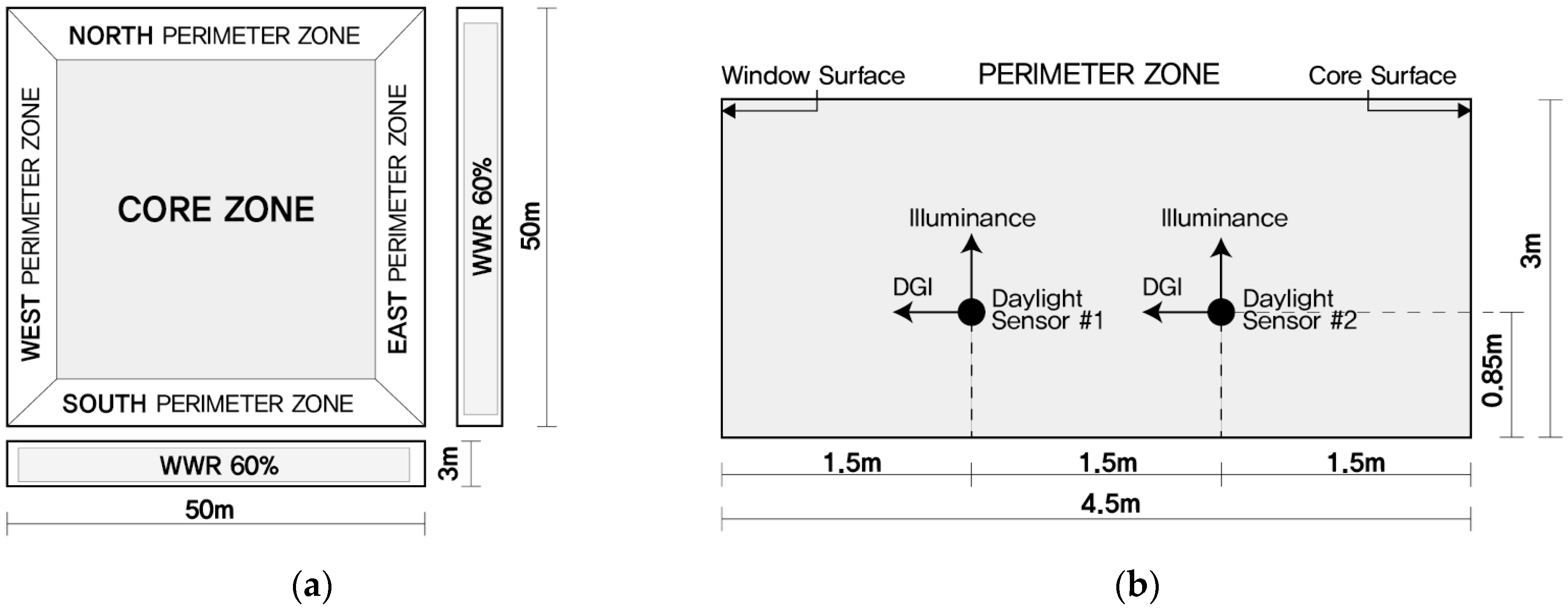

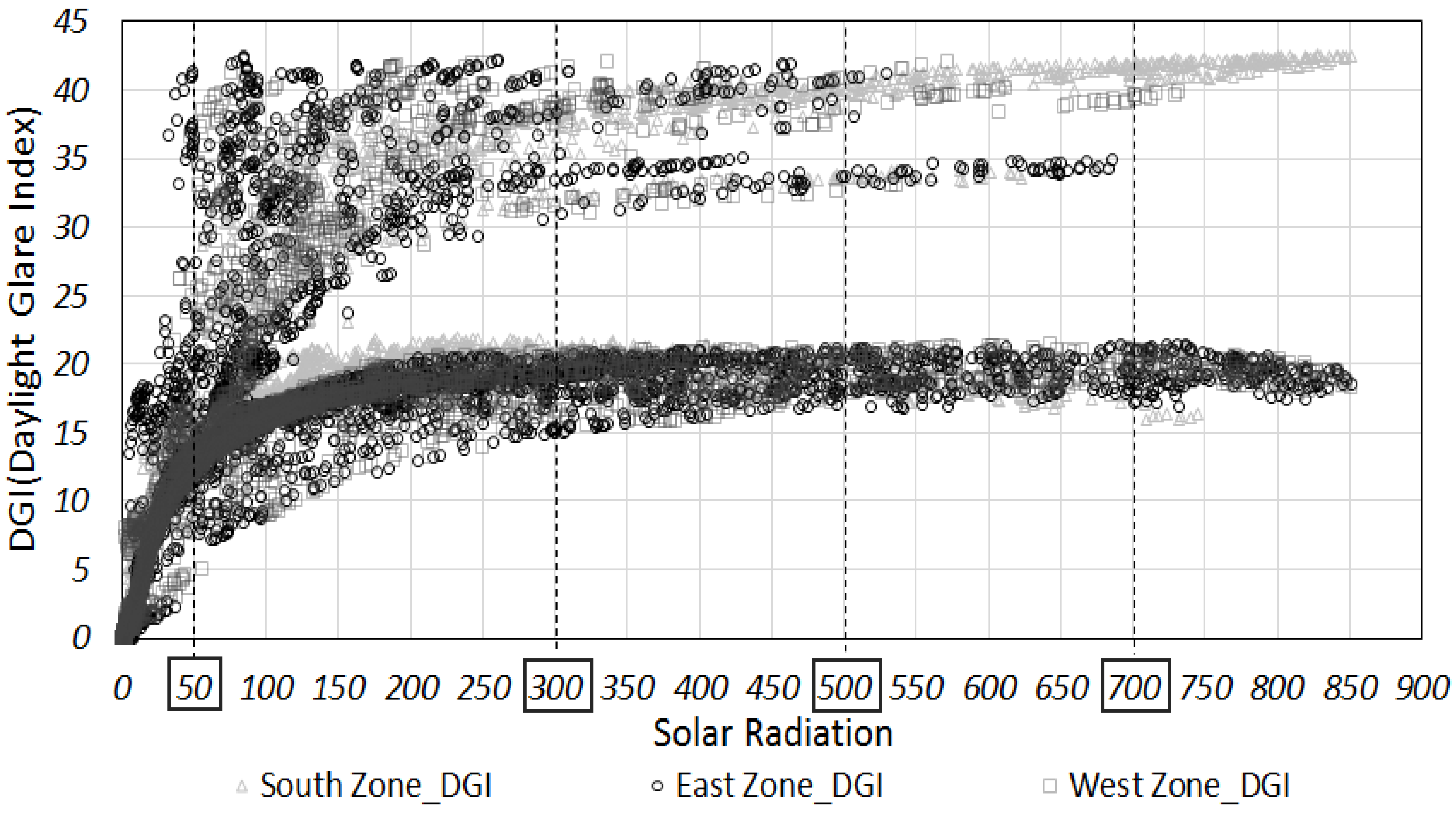
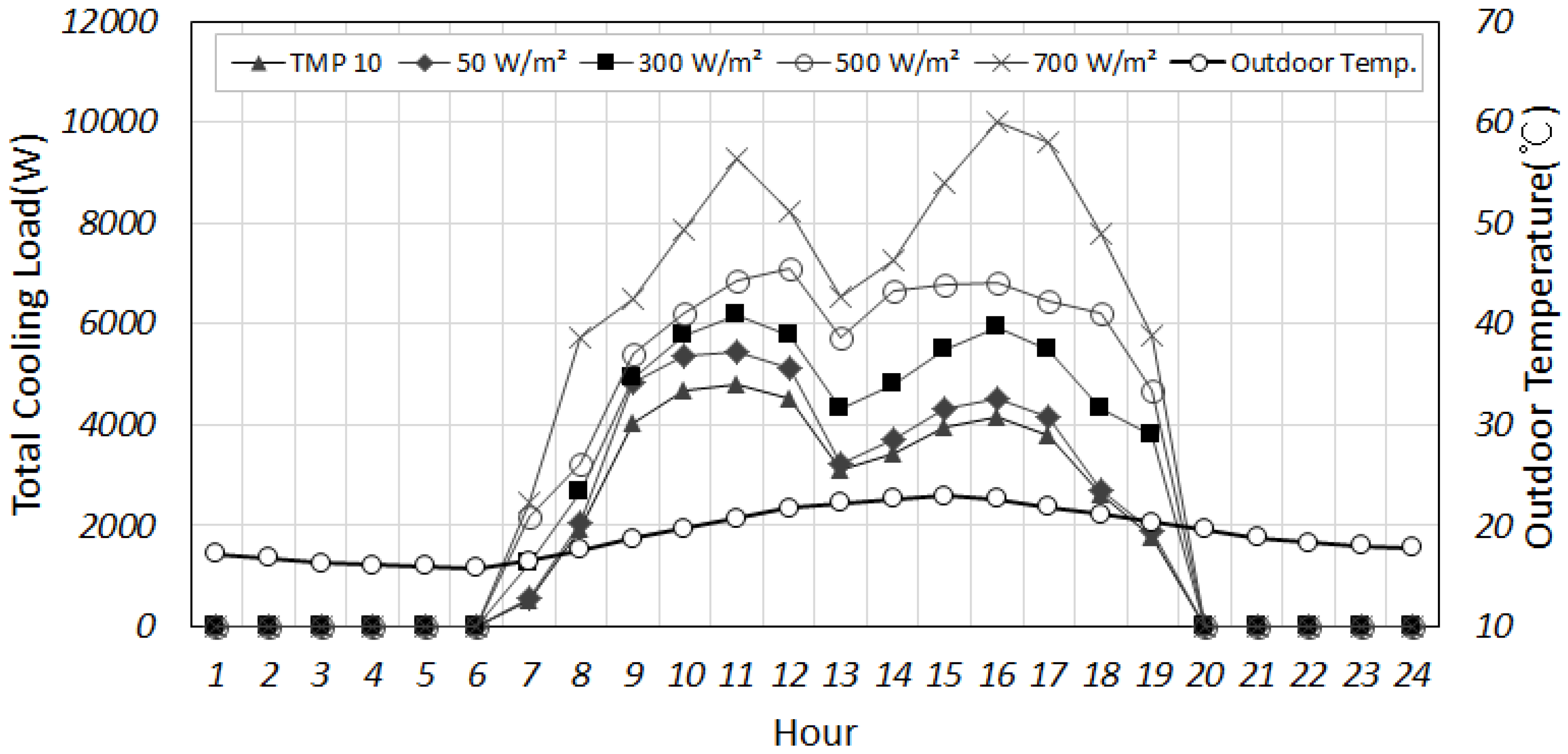
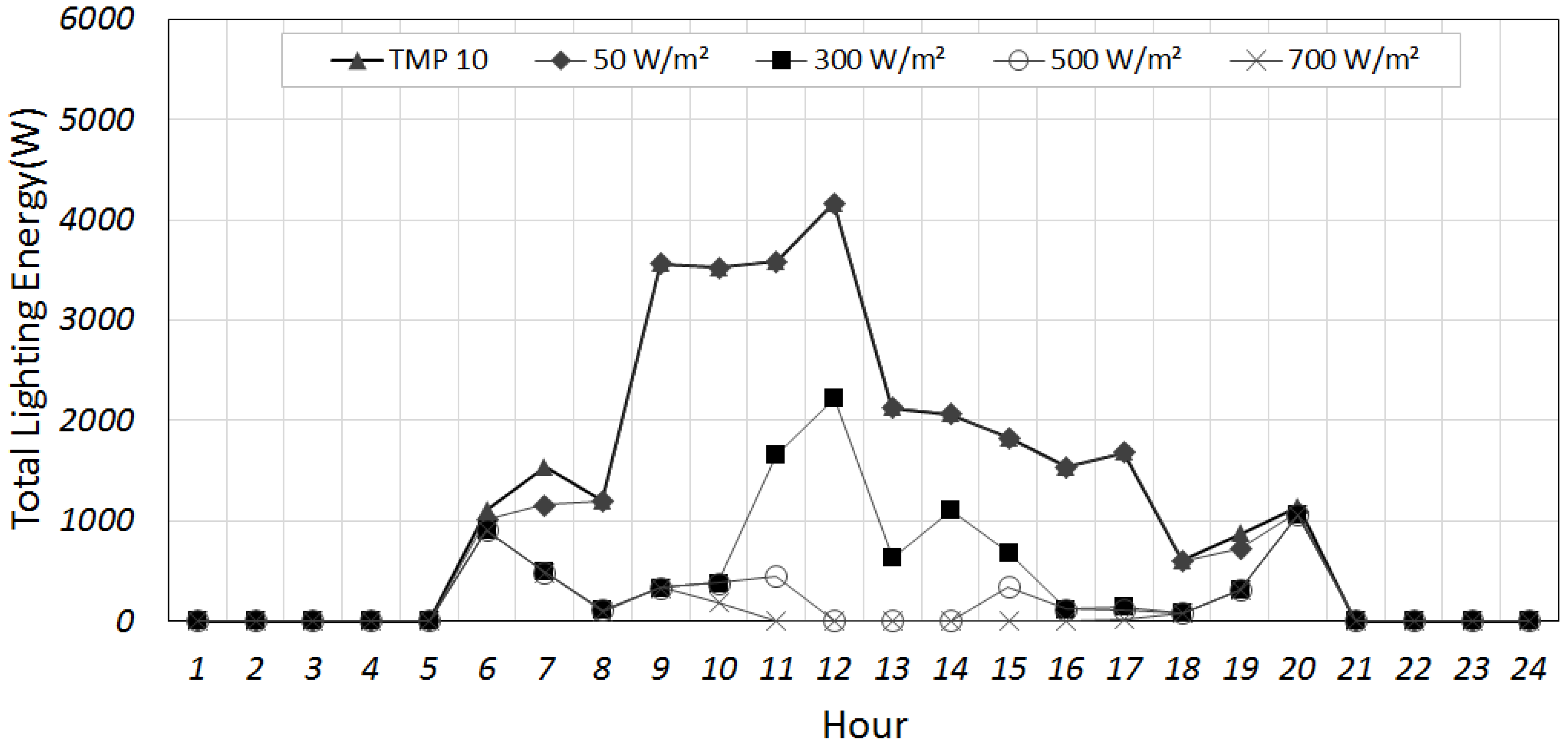







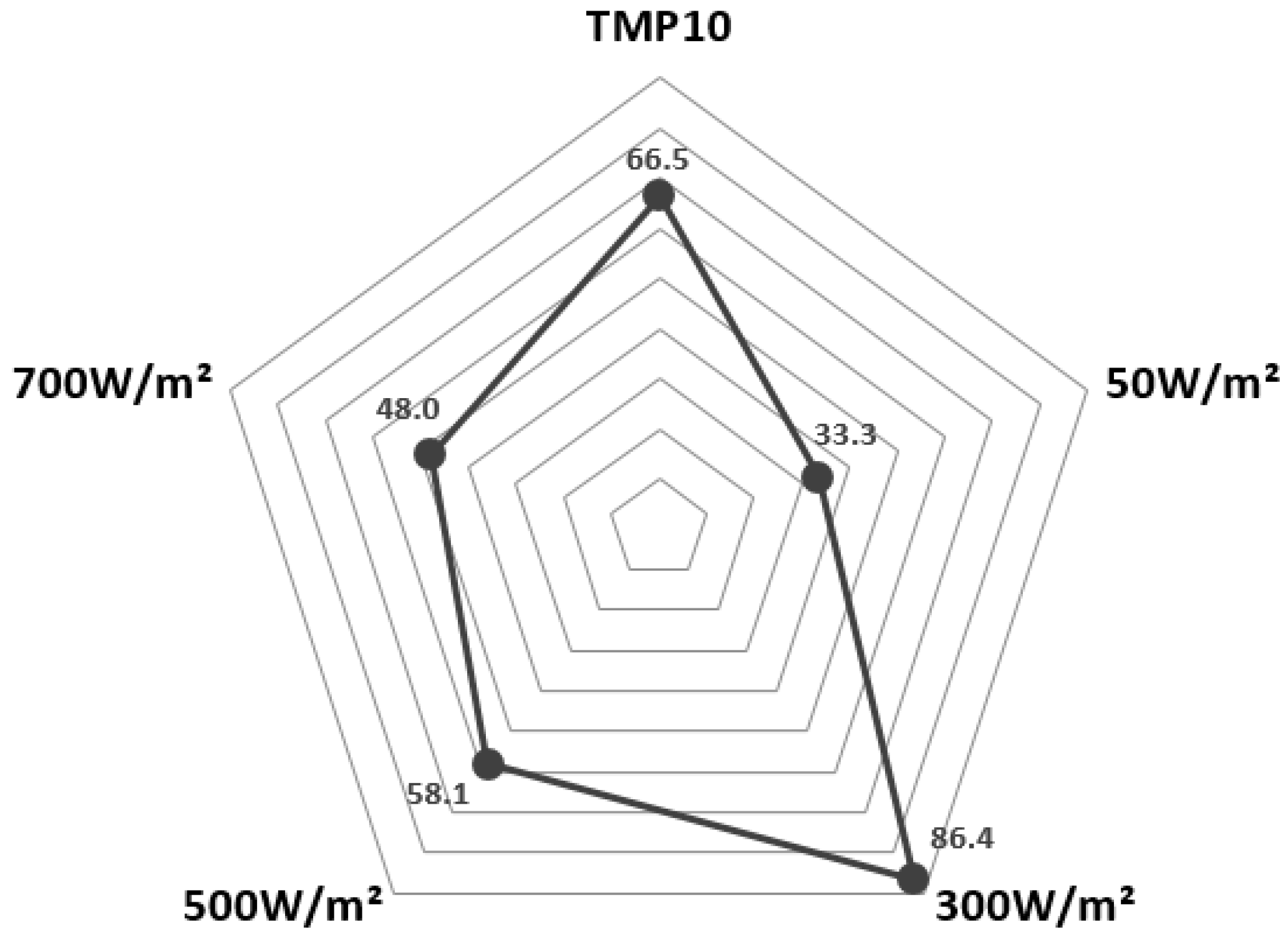
| Division | EC Glass (Bleached) | EC Glass (Colored) | |
|---|---|---|---|
| Thickness (mm) | 3 | 3 | |
| Solar Transmittance | front | 0.481 | 0.065 |
| back | 0.481 | 0.065 | |
| Solar Reflectance | front | 0.214 | 0.181 |
| back | 0.190 | 0.168 | |
| Visible Transmittance | front | 0.648 | 0.120 |
| back | 0.648 | 0.120 | |
| Visible Reflectance | front | 0.128 | 0.074 |
| back | 0.111 | 0.062 | |
| Division | Materials | Thermal & Optical Properties | |
|---|---|---|---|
| Exterior Wall | 200 mm concrete 155 t insulation 19 mm gypsum board | U-value 0.202 W/m2 K | |
| Exterior Floor | 105 mm insulation 200 mm concrete | U-value 0.291 W/m2 K | |
| Exterior Roof | 100 mm concrete 220 mm insulation Ceiling air space Acoustic tile | U-value 0.136 W/m2 K | |
| Glazing | 44 mm Triple glazing (8 mm Electrochromic + 12 air + 6 mm clear glass + 12 mm air + 6 mm low-e glass) | Bleached | Colored |
| SHGC 0.357 Tvis 0.463 U-value 1.192 | SHGC 0.107 Tvis 0.085 U-value 1.192 | ||
| Condition for Controlling EC | Consideration Factor | ||||
|---|---|---|---|---|---|
| Temperature/Solar Radiation | Glare Reduction | Heating Load Reduction | Cooling Load Reduction | Lighting Energy Reduction | |
| 10 °C | △ | ● | ● | △ | |
| 50 W/m2 | ● | △ | ● | △ | |
| 300 W/m2 | ◎ | △ | ● | ◎ | |
| 500 W/m2 | △ | ◎ | ◎ | ◎ | |
| 700 W/m2 | △ | ● | △ | ● | |
| ●: Excellent ◎: Normal △: Weak | |||||
| Heating Load (kWh) | TMP 10 | 50 W/m2 | 300 W/m2 | 500 W/m2 | 700 W/m2 |
|---|---|---|---|---|---|
| South Zone | 7.2 | 11.5 | 15.5 | 20.7 | 22.0 |
| East Zone | 20.1 | 20.2 | 25.5 | 29.5 | 39.6 |
| West Zone | 16.1 | 16.2 | 19.7 | 24.1 | 34.3 |
| Total Heating Load | 47.6 | 48.0 | 60.7 | 74.3 | 95.9 |
| Lighting Energy (kWh) | TMP 10 | 50 W/m2 | 300 W/m2 | 500 W/m2 | 700 W/m2 |
|---|---|---|---|---|---|
| South Zone | 11.5 | 11.2 | 4.9 | 1.0 | 1.0 |
| East Zone | 8.1 | 8.0 | 3.0 | 1.8 | 1.2 |
| West Zone | 11.0 | 11.0 | 2.3 | 1.8 | 1.3 |
| Total Lighting Energy | 30.5 | 30.0 | 10.2 | 4.6 | 3.5 |
| Heating Load (kWh) | TMP 10 | 50 W/m2 | 300 W/m2 | 500 W/m2 | 700 W/m2 |
|---|---|---|---|---|---|
| South Zone | 22.3 | 27.2 | 26.8 | 25.2 | 23.1 |
| East Zone | 28.6 | 31.6 | 30.9 | 29.8 | 29.2 |
| West Zone | 31.6 | 34.2 | 33.9 | 32.7 | 32.1 |
| Total Heating Load | 82.5 | 93.0 | 91.6 | 87.7 | 84.5 |
| Lighting Energy (kWh) | TMP 10 | 50 W/m2 | 300 W/m2 | 500 W/m2 | 700 W/m2 |
|---|---|---|---|---|---|
| South Zone | 5.2 | 7.8 | 5.6 | 5.3 | 5.3 |
| East Zone | 6.8 | 15.8 | 6.8 | 6.8 | 6.8 |
| West Zone | 6.3 | 15.3 | 7.9 | 6.3 | 6.3 |
| Total Lighting Energy | 18.3 | 39.0 | 20.3 | 18.4 | 18.4 |
| Temperature/Solar Radiation | Consideration Factor | |||
|---|---|---|---|---|
| Heating Load Reduction | Cooling Load Reduction | Lighting Energy Reduction | ||
| Cooling Period | Heating Period | |||
| 10 °C | ● | ● | △ | ● |
| 50 W/m2 | △ | ● | △ | △ |
| 300 W/m2 | △ | ◎ | ◎ | ◎ |
| 500 W/m2 | ◎ | △ | ● | ● |
| 700 W/m2 | ● | △ | ● | ● |
| ●: Excellent ◎: Normal △: Weak | ||||
| Month | TMP 10 | 50 W/m2 | 300W/m2 | 500 W/m2 | 700 W/m2 | |
|---|---|---|---|---|---|---|
| Cooling Period (kWh) | April | 991.5 | 1097.5 | 543.7 | 564.4 | 780.3 |
| May | 2422.2 | 2394.9 | 1630.6 | 1761.7 | 1936.9 | |
| June | 4184.4 | 4152.3 | 3514.8 | 3658.0 | 3822.7 | |
| July | 5799.7 | 5757.0 | 5169.6 | 5319.2 | 5393.9 | |
| August | 6570.2 | 6519.3 | 6026.4 | 6193.1 | 6327.2 | |
| September | 4118.5 | 4040.9 | 3505.4 | 3762.2 | 3999.8 | |
| October | 2065.2 | 1947.0 | 1360.0 | 1520.3 | 1723.7 | |
| Total | 26,151.6 | 25,908.8 | 21,750.4 | 22,778.9 | 23,984.5 | |
| Heating Period (kWh) | November | 1258.3 | 1559.4 | 1050.3 | 982.1 | 1002.3 |
| December | 3224.8 | 4032.0 | 3555.3 | 3353.9 | 3268.9 | |
| January | 4539.3 | 5712.9 | 5245.7 | 4884.2 | 4754.4 | |
| February | 2794.6 | 3888.1 | 3391.0 | 3111.3 | 2914.7 | |
| March | 1185.4 | 2029.7 | 1341.9 | 1200.0 | 1118.6 | |
| Total | 13,002.5 | 17,222.0 | 14,584.2 | 13,531.6 | 13,058.9 | |
| Energy Consumption (kWh) | TMP 10 | 50 W/m2 | 300 W/m2 | 500 W/m2 | 700 W/m2 |
|---|---|---|---|---|---|
| Heating Load | 9777.4 | 11,928.1 | 11,573.2 | 10,689.5 | 10,192.9 |
| Cooling Load | 19,152.4 | 18,909.7 | 18,988.4 | 20,379.3 | 21,725.8 |
| Lighting Energy | 10,224.3 | 12,293.0 | 5773.1 | 5241.7 | 5124.7 |
| Total Load & Energy | 39,154.1 | 43,130.8 | 36,334.7 | 36,310.5 | 37,043.4 |
| Temp/Solar Radiation | Element (i) | Total | Average | |||
|---|---|---|---|---|---|---|
| Heating, Cooling, & Lighting (kWh) | DGI over 22 | LUX 150 lx–1500 lx | ||||
| Raw Data (j) | 10 °C | 39,154.1 | 89.1% | 52.3% | — | — |
| 50 W/m2 | 43,130.8 | 93.3% | 32.3% | |||
| 300 W/m2 | 36,334.7 | 89.3% | 56.2% | |||
| 500 W/m2 | 36,310.5 | 84.0% | 48.6% | |||
| 700 W/m2 | 37,043.4 | 83.4% | 45.4% | |||
| EDPI | 10 °C | 58.3 | 57.6 | 83.7 | 199.6 | 66.5 |
| 50 W/m2 | 0.0 | 100.0 | 0.0 | 100.0 | 33.3 | |
| 300 W/m2 | 99.6 | 59.6 | 100.0 | 259.2 | 86.4 | |
| 500 W/m2 | 100.0 | 6.1 | 68.2 | 174.3 | 58.1 | |
| 700 W/m2 | 89.3 | 0.0 | 54.8 | 144.1 | 48.0 | |
© 2018 by the authors. Licensee MDPI, Basel, Switzerland. This article is an open access article distributed under the terms and conditions of the Creative Commons Attribution (CC BY) license (http://creativecommons.org/licenses/by/4.0/).
Share and Cite
Oh, M.; Park, J.; Roh, S.; Lee, C. Deducing the Optimal Control Method for Electrochromic Triple Glazing through an Integrated Evaluation of Building Energy and Daylight Performance. Energies 2018, 11, 2205. https://doi.org/10.3390/en11092205
Oh M, Park J, Roh S, Lee C. Deducing the Optimal Control Method for Electrochromic Triple Glazing through an Integrated Evaluation of Building Energy and Daylight Performance. Energies. 2018; 11(9):2205. https://doi.org/10.3390/en11092205
Chicago/Turabian StyleOh, Myunghwan, Jaesung Park, Seungjun Roh, and Chulsung Lee. 2018. "Deducing the Optimal Control Method for Electrochromic Triple Glazing through an Integrated Evaluation of Building Energy and Daylight Performance" Energies 11, no. 9: 2205. https://doi.org/10.3390/en11092205




